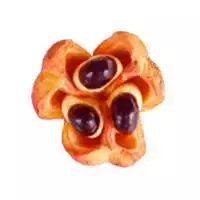Like

Aki fruit is rightfully considered the national fruit of Jamaica. But this exotic fruit, which is completely unusual for us, requires a special approach to itself, since its use in an unbreakable and fresh state can adversely affect not only health, but even human life. At the same time, properly prepared aki fruit is an incredibly tasty product that has an original nutty flavor.
Bligia tasty (as aki fruit is often called) is a fruit of an evergreen tree belonging to the sapind family. And despite the fact that this tree is a national Jamaican symbol, its homeland is West Africa, from where the plant got to the Caribbean in the 18th century. The first saplings of aki trees were transported on a ship transporting African slaves.
Today, the range of growth of this plant is truly wide. It can be found not only in West Africa, but also in the Bahamas and Antilles, Barbados, Colombia, Central America and even Ecuador. Unfortunately, however, in most of these countries, the fruit of the aki tree is not recognized as edible due to the high content of toxins that are life-threatening. Meanwhile, during heat treatment, all toxic substances completely disappear and the aki fruit becomes more than suitable for food consumption.
The yellowish-red fruit of the tree, that is, the aki fruit, is rather unusual - it has a pear-shaped shape, and its length is about 10 centimeters. When the fruit is fully ripe, it cracks, and then a juicy beige flesh begins to peep out from under the peel. Glossy black seeds of large size are attached to this pulp. Exclusively mature fruit pulp with its characteristic soft taste of nuts is suitable for food. Among the people, aki fruit is often called the "vegetable brain" for the appearance of an edible core, which really resembles the appearance of a person's brain.
In Jamaica, it is customary to cook surprisingly delicious side dishes from aki fruit - for this, ripe fruits are simply fried in oil. To taste, these dishes are somewhat reminiscent of a regular omelette, which is probably why locals often make it for breakfast. Boiled fruits are eaten with bacon or jerky fish, vegetables and spices. Often, the fruit is served with fritters or toasted fruits of a breadfruit.
And in West Africa, aki fruit is not only eaten - they came up with the use of its inedible part. Soap is produced from immature fruits and peels, and the flesh of green fruits goes to the manufacture of a special poison, with the help of which local fishermen catch the inhabitants of the water depths.
aki 151 kKal
Energy value of aki (Ratio of proteins, fats, carbohydrates - ju):
Proteins: 1 g (~ 4 kCal)
Fats: 15g (~ 135 kCal)
Carbohydrates: 8g (~ 32kCal)
Energy ratio (bj | y): 3% | 89% | 21%
 Español
Español Français
Français Português
Português Русский
Русский 简体中文
简体中文 繁體中文
繁體中文 日本語
日本語 한국어
한국어 العربية
العربية Türkçe
Türkçe Қазақ
Қазақ Deutsch
Deutsch Italiano
Italiano Українська
Українська
